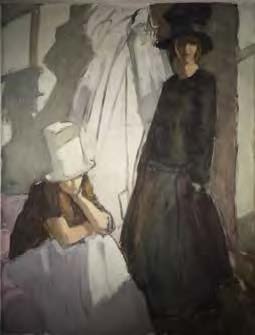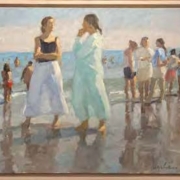The Artist’s Muse … Ask the artsperts

Kristine Meek and Juliana Meek
Dear Artsperts,
I heard the painter Richard Segalman died. That’s such a shame. I enjoyed taking his watercolor classes over the years. I wonder if you have any advice for artists that want their artwork to live on after they have passed on.
Sincerely,
Life After Death
Dear Life,
Yes, regrettably Richard Segalman, the master of oil, pastel, monoprint and watercolor, passed away last year. His long career saw his works purchased by a noted New York collector, David Daniels, who later gave these works to the permanent collection of the Metropolitan Museum of Art. In the 1970s, Joseph Hirshhorn purchased many Segalman works and later donated these works to the Hirshhorn Museum and Sculpture Garden.

“January Light” by Richard Segalman
Oil on canvas, 40”x 32”, 2009
Richard always had a great affinity for painting the pristine beaches of Naples, however his popularity was much broader than Naples. With works in more than 40 permanent public collections and the subject of two published books, Richard’s critical acclaim will help ensure his works live on. Also, how he handled his estate will as well.
Our advice for any artist is to carefully consider not just the physical artwork but also the copyright associated with your work. In the United States copyright remains with the artists’ heirs until 70 years after the artist’s death. Copyright matters because without written permission from a living artist or a deceased artist’s heirs, the artwork cannot be reproduced in any way. That means no books, catalogs, online exhibitions. This makes it very difficult to promote an artist if you can’t get permission to market the work. So we advise artists include in their wills who inherits the copyright and it could even be an institution or organization such as a university, an art museum, or a nonprofit charity.
Artists seeking life for their work after their death should also strive to get their work into museum collections. Thus helping to ensure the public viewing of their work. Donating artwork to a municipality, nonprofit, museum or university all come with a few caveats. For example, just because you leave it to them in your will, doesn’t mean they have to accept it. It’s best to have a discussion with the receiving institution and get in writing: what will be donated, how it can be used (can it be sold, and if so, how can the money be used and does the institution need to offer the work to a particular party first), and perhaps offer the institution the copyright for that donated work.
As we always say, artists should talk with their attorneys and accountants, but these are two areas we think are worth considering.
It’s for the benefit of everyone that these artworks live on and bring joy, even though the artist is only with us in spirit.
Sincerely,
The Artsperts 
599 NINTH STREET NORTH SUITE 309 | NAPLES, FL 34102 | 239.261.2637
FEATURED ART: “Conversation” by Richard Segalman Oil on canvas, 24”x 30”




Leave a Reply
Want to join the discussion?Feel free to contribute!